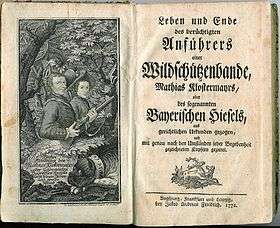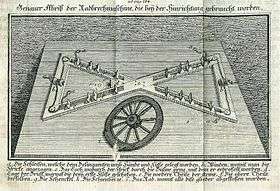Matthias Klostermayr



Matthias Klostermayr, known as Bavarian Hiasl (in German Bayerische Hiasl, in Austro-Bavarian Boarische Hiasl) (3 September 1736—6 September 1771) was a renowned German outlaw, poacher and social rebel who had come to be described, particularly in accounts written in the English-speaking world, as the Bavarian Robin Hood.
A native of the municipality of Kissing near Augsburg (his name, in Austro-Bavarian, on the baptismal register is Mattheus Klostermair), Bavarian Hiasl became an outlaw, first as a poacher and ultimately as the Robin Hood-like leader of a gang of robbers who, during the 1760s, plundered, sacked and robbed in the region between Munich, Augsburg and Swabia. Although, by 1771, he was captured and put to death by breaking on the wheel, his mythical accumulated treasure was never found, and legends surrounding its purported whereabouts have placed it somewhere near one of his hideouts, an old cave in Kuchelschlag Wood or on Jexhof Farm.
In Bavaria he has been a folk hero, with books, songs, musicals and a modern multimedia museum in Kissing ("Hiasl Erlebniswelt", or "the World of Hiasl"), which recreates for visitors the life and times of the "German prince of forests", the "Bavarian Robin Hood", whose gruesome execution took place in Dillingen an der Donau. Ten years later, in 1781, Friedrich Schiller is presumed to have based Karl Moor, the tragic protagonist of his first play, The Robbers, on the Bavarian Hiasl who, in the 2000s, nearly 250 years after his death, still captures the imagination.
References
- Hansen, Walter (1978). Das war der Bayerische Hiasl: Deutschlands berühmtester Wildschütz und Räuberhauptmann. Pfaffenhofen
- Schelle, Hans (1991). Der Bayerische Hiasl. Lebensbild eines Volkshelden. Rosenheim ISBN 3-475-52701-4
- Drexler, Toni, et al. (2002). Im Wald da sind die Räuber: Kneißl, Hiasl & Co. Räuberromantik und Realität. Schöngeising. ISBN 3-932368-07-X